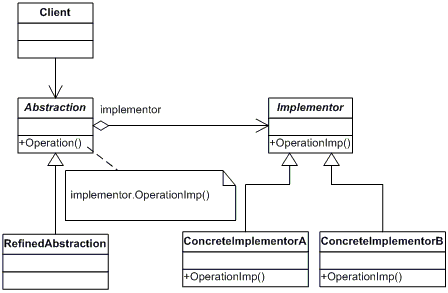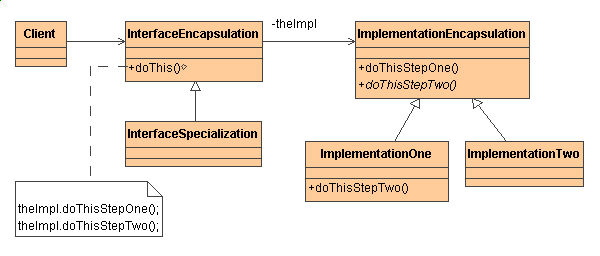Difference between revisions of "Bridge"
(→Consequences) |
(→Participants) |
||
| Line 25: | Line 25: | ||
== Participants == | == Participants == | ||
The classes and/or objects participating in this pattern are: | The classes and/or objects participating in this pattern are: | ||
| − | + | <ul> | |
| − | <li>defines the abstraction's interface | + | <li>'''Abstraction'''</li> |
| − | <li>maintains a reference to an object of type Implementor | + | <ul> |
| − | + | <li>defines the abstraction's interface</li> | |
| − | <li>extends the interface defined by Abstraction. | + | <li>maintains a reference to an object of type Implementor</li> |
| − | + | </ul> | |
| − | <li>defines the interface for implementation classes. This interface does not have to correspond exactly to Abstraction's interface; in fact the two interfaces can be quite different. The Implementation interface provides only primitive operations, and Abstraction defines high-level operations based on these primitives. | + | <li>'''Refined Abstraction'''</li> |
| − | + | <ul> | |
| − | <li>implements the Implementor interface and defines its concrete implementation. | + | <li>extends the interface defined by Abstraction.</li> |
| + | </ul> | ||
| + | <li>'''Implementor'''</li> | ||
| + | <ul> | ||
| + | <li>defines the interface for implementation classes. This interface does not have to correspond exactly to Abstraction's interface; in fact the two interfaces can be quite different. The Implementation interface provides only primitive operations, and Abstraction defines high-level operations based on these primitives.</li> | ||
| + | </ul> | ||
| + | <li>'''Concrete Implementor'''</li> | ||
| + | <ul> | ||
| + | <li>implements the Implementor interface and defines its concrete implementation.</li> | ||
| + | </ul> | ||
| + | </ul> | ||
== Consequences == | == Consequences == | ||
Revision as of 20:04, 1 March 2007
The Bridge pattern is intended to decouple an abstraction from its implementation so both can vary independently. The Bridge pattern is also know as Handle/Body.
Contents
UML Structure
Here is an example of the Bridge pattern.

Source: Downloaded from http://www.dofactory.com/Patterns/PatternBridge.aspx
Here is another example of the Bridge pattern where it decouples the abstraction from its implementation so that the two can vary independently

Source: Downloaded from http://home.earthlink.net/~huston2/dp/all_uml.html
Applicability
The Bridge pattern is applicable when:
Participants
The classes and/or objects participating in this pattern are:
- Abstraction
- defines the abstraction's interface
- maintains a reference to an object of type Implementor
- Refined Abstraction
- extends the interface defined by Abstraction.
- Implementor
- defines the interface for implementation classes. This interface does not have to correspond exactly to Abstraction's interface; in fact the two interfaces can be quite different. The Implementation interface provides only primitive operations, and Abstraction defines high-level operations based on these primitives.
- Concrete Implementor
- implements the Implementor interface and defines its concrete implementation.
Consequences
The Bridge pattern has the following consequence:
Implementation
When applying the Bridge pattern, consider the following implementation issues:
Code Examples
Real-world Sample code in C#
This real-world code demonstrates the Bridge pattern in which a BusinessObject abstraction is decoupled from the implementation in DataObject. The DataObject implementations can evolve dynamically without changing any clients.
// Bridge pattern -- Real World example
using System;
using System.Collections;
namespace DoFactory.GangOfFour.Bridge.RealWorld
{
// MainApp test application
class MainApp
{
static void Main()
{
// Create RefinedAbstraction
Customers customers =
new Customers("Chicago");
// Set ConcreteImplementor
customers.Data = new CustomersData();
// Exercise the bridge
customers.Show();
customers.Next();
customers.Show();
customers.Next();
customers.Show();
customers.New("Henry Velasquez");
customers.ShowAll();
// Wait for user
Console.Read();
}
}
// "Abstraction"
class CustomersBase
{
private DataObject dataObject;
protected string group;
public CustomersBase(string group)
{
this.group = group;
}
// Property
public DataObject Data
{
set{ dataObject = value; }
get{ return dataObject; }
}
public virtual void Next()
{
dataObject.NextRecord();
}
public virtual void Prior()
{
dataObject.PriorRecord();
}
public virtual void New(string name)
{
dataObject.NewRecord(name);
}
public virtual void Delete(string name)
{
dataObject.DeleteRecord(name);
}
public virtual void Show()
{
dataObject.ShowRecord();
}
public virtual void ShowAll()
{
Console.WriteLine("Customer Group: " + group);
dataObject.ShowAllRecords();
}
}
// "RefinedAbstraction"
class Customers : CustomersBase
{
// Constructor
public Customers(string group) : base(group)
{
}
public override void ShowAll()
{
// Add separator lines
Console.WriteLine();
Console.WriteLine ("------------------------");
base.ShowAll();
Console.WriteLine ("------------------------");
}
}
// "Implementor"
abstract class DataObject
{
public abstract void NextRecord();
public abstract void PriorRecord();
public abstract void NewRecord(string name);
public abstract void DeleteRecord(string name);
public abstract void ShowRecord();
public abstract void ShowAllRecords();
}
// "ConcreteImplementor"
class CustomersData : DataObject
{
private ArrayList customers = new ArrayList();
private int current = 0;
public CustomersData()
{
// Loaded from a database
customers.Add("Jim Jones");
customers.Add("Samual Jackson");
customers.Add("Allen Good");
customers.Add("Ann Stills");
customers.Add("Lisa Giolani");
}
public override void NextRecord()
{
if (current <= customers.Count - 1)
{
current++;
}
}
public override void PriorRecord()
{
if (current > 0)
{
current--;
}
}
public override void NewRecord(string name)
{
customers.Add(name);
}
public override void DeleteRecord(string name)
{
customers.Remove(name);
}
public override void ShowRecord()
{
Console.WriteLine(customers[current]);
}
public override void ShowAllRecords()
{
foreach (string name in customers)
{
Console.WriteLine(" " + name);
}
}
}
}
Sample Code in Java
The following Java program illustrates the 'shape' example given above and will output:
import java.util.*;
/** "Implementor" */
interface DrawingAPI {
public void drawCircle(double x, double y, double radius);
}
/** "ConcreteImplementor" 1/2 */
class DrawingAPI1 implements DrawingAPI {
public void drawCircle(double x, double y, double radius) {
System.out.printf("API1.circle at %f:%f radius %f\n", x, y, radius);
}
}
/** "ConcreteImplementor" 2/2 */
class DrawingAPI2 implements DrawingAPI {
public void drawCircle(double x, double y, double radius)
{ System.out.printf("API2.circle at %f:%f radius %f\n", x, y, radius); }
}
/** "Abstraction" */
interface Shape {
public void draw(); // low-level
public void resizeByPercentage(double pct); // high-level
}
/** "Refined Abstraction" */
class CircleShape implements Shape {
private double x, y, radius;
private DrawingAPI drawingAPI;
public CircleShape(double x, double y, double radius, DrawingAPI drawingAPI) {
this.x = x; this.y = y; this.radius = radius;
this.drawingAPI = drawingAPI;
}
// low-level i.e. Implementation specific
public void draw() { drawingAPI.drawCircle(x, y, radius); }
// high-level i.e. Abstraction specific
public void resizeByPercentage(double pct) { radius *= pct; }
}
/** "Client" */
class BridgePattern {
public static void main(String[] args) {
Shape[] shapes = new Shape[2];
shapes[0] = new CircleShape(1, 2, 3, new DrawingAPI1());
shapes[1] = new CircleShape(5, 7, 11, new DrawingAPI2());
for (Shape shape : shapes) {
shape.resizeByPercentage(2.5);
shape.draw();
}
}
}